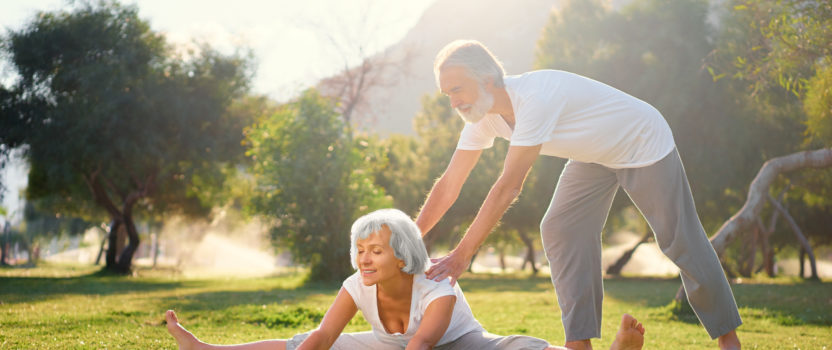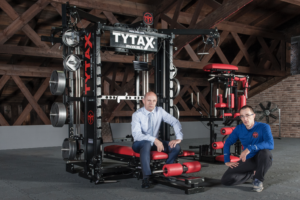The Phenomenon of Aging
Aging and ultimately death is characteristic of all living organisms. Atherosclerosis progressively reduces the supply of oxygen to tissues and organs such as the brain. As a result, cells die.
In other tissues, changes in cellular components in the aging process, such as the spine, cause the disappearance of connections between adjacent collagen fibers in the intervertebral discs, thereby reducing their flexibility and there is a high risk of mechanical damage. As a result, most of the biological functions of our body show a gradual, age-related deterioration of functioning.
The mechanisms underlying the aging process are not well understood. Some hypotheses speak about the “wear” of an organism that exceeds the tissue repair capacity, the development of resistance to individual protein components, cell division errors associated with the effects of external radiation on our body or endogenous mitogens, such as peroxidase. There is also a hypothesis that aging is “programmed” by evolution to avoid the danger of overpopulation.
Age Classification and Biological Functions
We usually achieve a physical and biological peak at the age of 20-35. At the age of 35-45, a physical activity usually disappears, and our body usually accumulates from 5 to 10 kg of fat. Mobilization for physical exercise and active rest during this period is diminishing. Consequently, as the need to impress the person with the opposite sex or, for example, the employer, is reduced. At a later age, 45-65 years, women are already menopausal, and in men, there is also a significant reduction in the level of sex hormones. In this age, we reach the top of our professional career and are associated with it mostly high income.
We spend our free time on trips or holidays, going to a restaurant. The decline in fitness at this age is noticeable and usually accelerates. At the beginning of the old age (65-75 years), even a small increase in physical activity may occur. The decrease is related to the fact that after finishing work and retiring, we have much free time and try to do something about it. In the middle of old age (75-85 years) many people are already physically disabled, and in the final phase of old age (over 85 years old) man becomes entirely dependent.
Individual Differences
There are of course vast individual differences between people in their functional state at a given chronological age. People who care about their health, especially the maximum oxygenation and strength and flexibility of their muscles, at the age of 65, can match the functionality of their bodies with a 25-year-old who leads a sedentary lifestyle. Thus, there are significant differences between chronological and biological age for individual individuals, and for example decisions regarding suitability for employment in a given profession should be made by biological age, not sequential. Even some indicators, such as graying or hair loss, are not indicative of biological age.
Aging and Energy Consumption
The central part of our total daily energy requirement results from resting metabolism. Unfortunately, resting metabolism decreases with age by about 10% from early adulthood to retirement age, and another 10% at a later date. One of the reasons for the decrease in resting metabolism is the loss of metabolically active muscle mass and the parallel increase in body fat, which is indifferent to resting metabolism. In late life, there may be a further general reduction in cellular metabolism. However, while adjusting the food intake to the ever-smaller resting and cell metabolism, we must remember that in the food consumed there are fewer nutrients, including protein and calcium. The ingredients can be supplemented with synthetic dietary supplements or increase their intake through physical exercise.
Aging and Decrease in Oxygen Uptake by the Body
Oxygen is an essential component of cell metabolism. A man shows maximum oxygen uptake at the age of about 25 years. With time, oxygen intake, unfortunately, falls systematically. Even in athletes, with chronological age, there is a decrease in oxygen consumption, but to a much lesser degree than in people who lead a sedentary lifestyle. Mainly due to the reduction in the maximum heart rate, stroke volume and arterio-venous difference in oxygen saturation.
1. Heart rate
The maximum heart rate decreases primarily due to the reduced sensitivity to catecholamine circulation. The classical equation [peak value = 220 beats/min – age in years] means a maximum of about 155 beats/min at the age of 65. There are times when a 65-year-old who is in good physical condition can reach speeds of up to 170 beats per minute. The peak values of heart rate that we can achieve as the chronological age progresses can be limited if we suffer, for example, chronic lung disease or myocardial ischemia.
2. Ejection volume of the heart
In general, the chronological age affects the ejection volume of the heart. It happens that in the elderly, the ejection volume of the heart at maximum effort may be even higher than in young people. However, older people have difficulty maintaining this maximum volume for a more extended period. Mainly due to the loss of myocardial and arterial flexibility, also due to the development of myocardial ischemia. With age, the arterio-venous difference in oxygen levels also decreases.
3. Consequences of falling oxygenation of the organism
The heart rate and heart rate dropping with biological age encourage the oxygenation of the body. Various types of illness can accelerate this process or delayed by an active lifestyle. The consequence of the falling oxygenation of the organism is fast fatigue while performing work, home activities or other physical work, and even in the elderly when we walk.
Aging of the Musculoskeletal Function
Aging leads to a progressive decrease in muscle strength and flexibility of the entire body.
1. Muscles
The man reaches peaks of performance about 25 years; then there is a slight decrease to the age of 35-40, which then accelerates to show about 25% of power at the age of 65. The gradual loss of muscle mass and the associated strength gradually impede every day of our lives. Even simple activities such as transferring 5 kg of food packaging, opening a vial with medicine or cleaning are sometimes more than forceful. Generally, the loss of muscle strength in women is faster than in men.
2. Flexibility
Loss of ability is due to the loss of elasticity of tendons, ligaments and joint capsules, the loss of connections between neighboring collagen fibers in the intervertebral discs. Loss of muscle mass, strength and muscle flexibility causes that a man has difficulty performing the simplest activities such as getting into a car, climbing stairs or even walking.
3. Bone structure
With age, the calcium content in our bones decreases. These changes are more pronounced in women than in men and occur at an earlier age. These changes may start at the age of 30 in women and accelerate in the period around menopause.
In old age, bones become so weak that a mild fall, a coughing attack, and even intense muscular contractions can cause “pathological” fractures. A hip fracture quite often initiates irreversible lying in bed and is the cause of death.
4. Aging of metabolic functions
Many hormonal control mechanisms work less efficiently in older people. The reaction applies, especially to the pancreas and thyroid gland. This process supports in a particular way obesity and the lack of physical activity along with age.
Exercises Against Aging
Aging is a process written in our genes. However, there is the possibility of a delay with the knowledge that slows the process and what speeds it up.
Of the many factors that delay the aging process, physical exercises are critical. Muscle strength can be significantly improved even in people who are already very old. The benefits of strengthening muscle strength are invaluable. The benefits of physical exercise are;
1. Regular physical exercise contributes to weight reduction.
2. Regular physical exercises affect the maintenance of a correct posture.
3. Regular physical exercises help in the fight against many diseases such as of example, diabetes, thyroid gland.
4. Regular physical exercise contributes to the increase in bone tissue strength.
5. Regular physical exercise can stop and sometimes even reverse the loss of bone tissue.
6. Regular physical exercises contribute to the increase in the flexibility of our body.
7. Regular physical exercise increases the uptake of nutrients, including the supply of micronutrients, protein, and calcium necessary for the body.
8. Regular physical exercise increases active muscle mass and at the same time reduces the amount of adipose tissue, greater current muscle mass increases resting metabolism.
9. Regular physical exercise increases the flexibility and strength of tendons, ligaments and joint capsules.
10. Regular physical exercise increases the heart rate and the ejection volume of the heart, and consequently increases the body’s oxygen uptake which transfers to better oxygenation of the body.
Exercises Reduce Stress
11. Regular physical activity significantly reduces stress and fight neuroses.
12. Through regular physical exercises for the abdominal and back muscles, we can build a strong corset with muscles that will protect us against spinal injuries.
13. Strong abdominal muscles are a great way to fight overweight, and they will first give you a signal that your natural weight has minimally exceeded.
14. Taking care of the proper condition of the neck muscles, we will protect ourselves against permanent degenerative changes in the cervical spine, headaches and upper back pains.
15. Physical exercise is excellent prophylaxis in osteoarthritis, forcing the joint to work under a light load increases the lubrication of the joint capsule, ligament strength and pot life of the joint capsules.
16. Regular physical exercise reduces the risk of falls.
Exercises with Weights
Among the many forms of physical activity, the best choice is a varied workout with weights for the maximum amount of muscles. If the training with weights taken by a senior who has not been physically active before, A person must start exercises with minimal loads. Practices with small loads do not pose a higher risk to the heart than staying with the sedentary lifestyle. It is tough to motivate older people to exercise, and in particular to apply with weights, because the majority of older people reconcile with the state of their biological age. Indeed, influenced by the fact that it is difficult to take physical exercises in an older or an elderly age if we have never done them in our lives. Moreover, you can turn your biological age back by up to 20 years by undertaking physical exercises.
Who Cares about Our Health
Is there someone besides us who cares more about our health? Probably not. Our health depends in no small extent on ourselves, and we must put much effort into our lives not to lose this gift. In this fight for our health, physical exercises play a vital role. Older adults in exercising should be assisted primarily by their children. This help may be a matter of raising parents’ awareness of the importance of physical exercise for their health and physical fitness.
Sometimes it can also be helpful in buying the equipment necessary for training. Remember that helping our parents in their effort for better physical fitness in the elderly and old age, we change not only their lives for the better, but also improve the quality of our lives. Of course, it is also essential to show our parents an example of how important physical exercise is to health. Remember that our old age begins today. What we do for health at the age of 20 or 30 will translate into our health in old age.
When Should We Start to Practice
When should we start to take care of our health by doing physical exercises at least a few times a week? Every moment in our life is right, but the faster physical activity, and especially training with weights will become part of our everyday life, the better for our health. It is never too early, and it is never too late to start practicing. To exercise regularly, we must first of all be aware of the benefits of their regular exercise. Then even a senior or older adult will be motivated to train regularly with a load.
Unfortunately, many people have knowledge of the benefits of regular exercise, but they do not transfer this knowledge to their own lives and postpone the decision to start exercising for the future. They do not convince them to take overweight exercises, problems with the physical performance of the body. The signal for them that something terrible is happening is, for example, a heart attack or severe back problems. Then many of us reach the truth that prevention is better than cure.
Investing in Our Health
Moreover, yet physical exercise is one of the best investments in our health. Also, this is an investment that we can take at any moment of our lives. It is an investment that does not require significant financial outlays. Equipping a home gym requires sacrificing financial resources comparable to, for example, costs for a single vacation trip.
Let’s think about why we put huge funds on our pension system if, on the other hand, we do so little to use them as long as possible. It is never too late to change it, and the decision depends only on you.
Stanislaw Szultka
TYTAX Inventor and Founder





